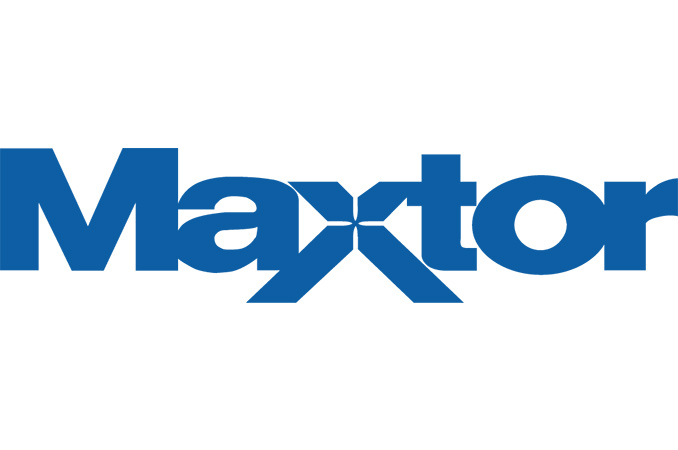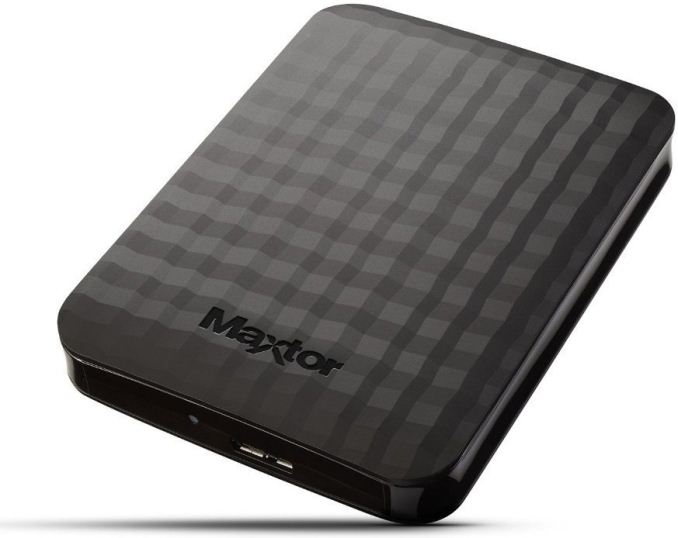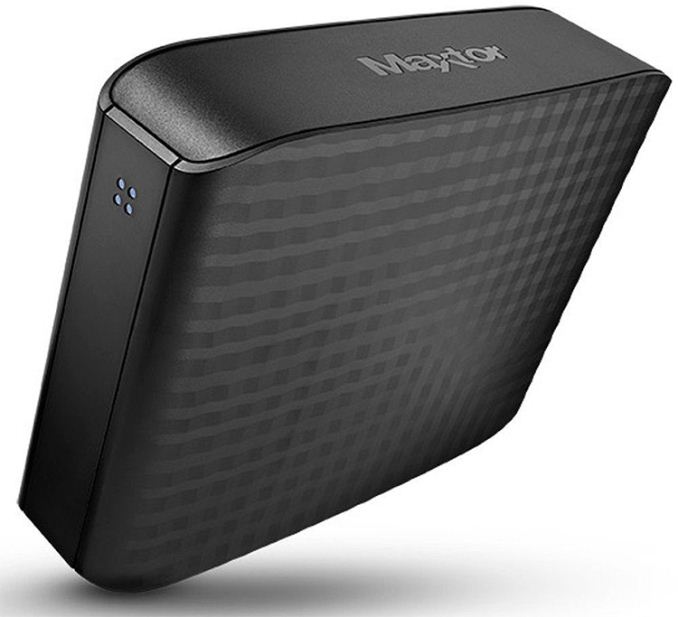Seagate Revives Maxtor Brand for External Storage
by Anton Shilov on December 1, 2016 8:00 AM EST
UPDATE 12/1 9AM: Seagate confirmed Thursday that it decided to revive the Maxtor brand in a bid to sell value products. In the coming months the company plans to phase-out its inexpensive Samsung-branded products and Maxtor will take their place.
Seagate has quietly started to sell Maxtor-branded external storage devices in various countries. At present, the company offers the Maxtor M3 and the Maxtor D3 Station DAS devices, which it also sells under the Samsung name (yes, you read that right - click here for proof). Right now, it is unclear for how long Seagate plans to use the trademark, which it has not touched for quite a while.
Maxtor was a major maker of hard drives that was founded in 1982 and acquired by Seagate in 2006. In the early 2000s, Maxtor was the largest maker of HDDs in the world after its acquisition of HDD division from Quantum, but its advantages somewhat diminished by the middle of the decade due to various reasons, such as the lack of a comprehensive lineup of 2.5” hard drives in the product stack. Maxtor faced severe financial troubles for the most part of its history, and after it was acquired it was also plagued by quality problems as well as controversial management decisions. After Seagate took the company over in 2006, it did ship Maxtor-branded internal and external drives for a couple of years (in fact, external storage was a strong side of Maxtor), but eventually the trademark was dropped.
Earlier this year Seagate decided to start using the Maxtor brand again to sell its M3 and D3 Station external storage products. Both of the DAS devices are also known as the Samsung M3 as well as the Samsung D3 Station which are available worldwide today. In fact, it is surprising to see that Seagate still uses the Samsung brand for hard drive products about five years after the acquisition of Samsung’s HDD business. Under the initial agreement, Seagate had rights to use the Samsung trademark for hard drives for 12 months following the buyout. Apparently, the two companies have amended the initial agreement as Seagate currently offers four Samsung-branded products for consumers. Meanwhile, the revival of the Maxtor brand could indicate that Seagate has begun to phase-out use of the Samsung trademark for its products, which is why it creates alternatives featuring a different brand (some may say that we are dealing with a plain re-badging).
| Seagate’s Maxtor DAS Lineup | ||||||
| Product | Capacity | Interface | Dimensions W×L×H (mm) |
Model Number | ||
| M3 | 500 GB | USB 3.0 | 82 × 112 × 17.5 | STSHX-M500TCBM | ||
| 1 TB | STSHX-M101TCBM | |||||
| 2 TB | STSHX-M201TCBM | |||||
| 3 TB | 82 × 118.2 × 19.85 | STSHX-M301TCBM | ||||
| 4 TB | STSHX-M401TCBM | |||||
| D3 Station | 2 TB | 129.2 × 180.6 × 129.2 | STSHX-D201TDBM | |||
| 3 TB | STSHX-D301TDBM | |||||
| 4 TB | STSHX-D401TDBM | |||||
| 5 TB | STSHX-D501TDBM | |||||
The Maxtor M3 external drive offers 500 GB, 1 TB, 2 TB and 4 TB capacities via a USB 3.0 interface. The top of the range Maxtor M3 model is based on the Spinpoint M10P 2.5”/15 mm HDD with five 800 GB platters featuring shingled magnetic recording technology at 5400 RPM spindle speed as well as 16 MB of cache. In the meantime, models with lower capacities use different hard drives and have smaller dimensions. The DAS comes with AutoBackup and SafetyKey software for automatic backup and protection.
The Maxtor D3 Station uses two 2.5” HDDs to offer 2 TB, 3 TB, 4 TB and 5 TB capacities (as opposed to up to 6 TB offered by the Samsung D3 Station version). Just like the M3, the DAS uses a USB 3.0 interface both for data transfer and for power. In addition it also comes with AutoBackup and SafetyKey. Since the D3 Station is designed to serve essential storage needs, it is basically a JBOD device that does not offer any kind of RAID for additional performance or reliability (it also makes for an inconsistent performance profile).
At present, Seagate uses its own brand to sell various external storage devices, the LaCie trademark for premium DAS products and the Samsung brand for select inexpensive external storage solutions. On Thursday the company said that it plans to continue using three brands for its external storage devices going forward with Maxtor taking the the place of Samsung. Seagate intends to add more products into the Maxtor lineup when it makes sense. The statement by Seagate reads as follows.
"Seagate’s consumer strategy is to have three brands to serve our customers varied external storage needs. Seagate (mainstream), LaCie (premium/creative pro) and Maxtor (value)," the company indicated. "The Samsung external HDD line is indeed being transitioned to the revived Maxtor brand. We will continue to provide products under the Maxtor brand and evolve the line as it makes sense."
At present, the Maxtor M3 and the Maxtor D3 Station products are available at Amazon and multiple other online and retail stores across the world.
Related Reading:
Source: Seagate












36 Comments
View All Comments
nagi603 - Thursday, December 1, 2016 - link
Well, there is a brand I trusted even less than Seagate. Especially after Seagate's newest offerings being actually reliable. I still remember a Maxtor HDD almost eating my years-long assignment.Arbie - Thursday, December 1, 2016 - link
From these pictures it's apparent that Maxtor drives will have the same lack of ventilation as the Seagates. With predictable results. It's incredible that a company can produce such a technical marvel as the hard drive and not be able to put holes in a plastic box. Do they have the cleaning staff design the packaging?BrokenCrayons - Thursday, December 1, 2016 - link
I'm not sure if you know it, but your ranting comment is probably one of the most amusing I've read here at AT in weeks. The line about the cleaning staff designing the package had the beauty of freshly shed unicorn tears, glimmering in the light cast by the morning sun as it rises from behind the hills around a tranquil, untouched forest. And no, those tears didn't come from Charlie the Unicorn either.I just thought you might wanna know. Please keep up the great work you're doing here. :)
aakash_sin - Friday, December 2, 2016 - link
Haha! :P #OwnedBenJeremy - Thursday, December 1, 2016 - link
Yeah, It seems that Seagate, when they bought Maxtor, switched over to all of the bad engineering and manufacturing of Maxtor, and shed whatever decent tech it had, because that was the moment Seagate quality tanked. I have stacks of Seagate drives, none I've owned in the past 10 years have lasted more than a few years - most taking terabytes of data without a single warning. As it stands, in terms of quality, Hitachi #1 (I'd trust a used server pull with 20k hours over a new Seagate), WD #2 (their network line, mostly), Toshiba #3 (distant), and Seagate #NEVER-NADA-ZIP-ZILCH.Even worse, they swallowed up Samsung's HDD line by buying it up and shutting it down. Samsung also made great drives.
Senti - Thursday, December 1, 2016 - link
It's a real pity that Samsung's HDD line was shut down. I have their 1TB and 2TB drives that still work flawlessly. Low noise and temperature, no annoying clicks that modern drives are quite famous for and still 0 reallocated sectors.Samus - Thursday, December 1, 2016 - link
Samsung drives were very reliable, but very slow. Especially their laptop drives. Good storage drives. But system builders are looking for drives you can run an OS from and Samsung drives were just not competitive which is why they had almost no OEM wins. A stark contrast to their SSD products that have many OEM wins, only bested by Sandisk.We can only hope the Samsung IP goes to good use, or has already gone to use in the latest portfolio of products.
StevoLincolnite - Thursday, December 1, 2016 - link
The Samsung Spinpoint F3 was actually pretty good from a performance perspective.Sure it wasn't going to out-bench a Western Digital Black... But it was also a heap cheaper.
***
As for Seagate... The first HDD (That wasn't in a prebuilt) I bought back in the 90's was a Seagate Cheetah, it lasted a week and I haven't dared touch them since.
Got 7x Western Digital Element external drives, a Western Digital Green 2tb drive at the moment... And they have all been humming along fine for years, but that's ancedotal of course.
BurntMyBacon - Friday, December 2, 2016 - link
IIRC, the Spinpoint F3 launched prior to the WD Black that it competed with and still compared pretty decently after the WD Black launched. Could be nostalgia talking though.Anecdotally speaking, I've had quite the reverse of your experience. I had to service 49 systems over the span of 6 years with WD harddisks suffering from a distinctive clicking pattern and lack of function. I only had six clients with WD harddisks that were still functional. None of the drives (working or broken) were older than 18 months at time of service. I could identify WD brand harddisks by that sound over the phone. I've continued to deal with WD HDD failures at perhaps a slightly lesser rate. Though, I stopped keeping track after that period and hesitate to recommend anything from them short of a raptor drive. Seagate, on the other hand, made harddisks that I rarely ever had to service up until after the 1TB drives. Seagate got my recommendation until the Samsung Spinpoint F1 series launched. Seems like most major players in the industry had trouble to some extent making >1TB drives for a while. That said, the quality of Seagate has clearly waned and I've had to deal with more issues out of them since then. When Hitachi bought the IBM HDD division, I had plenty of reason to avoid them. There was a good reason the DeskStar lineup got the nickname "DeathStar" and IBM even got hit with class action lawsuits over it. That said, the Hitachi DeskStar of today is an entirely different beast. They've had my top spot since Samsung sold their HDD division to Seagate.
kmi187 - Friday, December 2, 2016 - link
The Samsung Spinpoint series starting from F1, were some of the fastest drives that were out on the market when they launched.